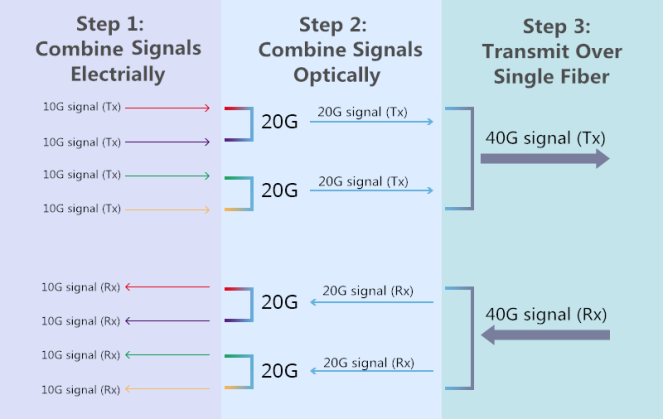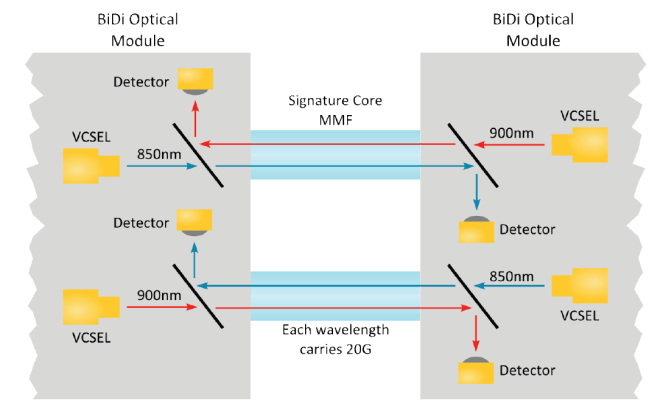As we know, duplex LC interface is commonly used for most 40G transmission in long distances, for instance, 40GBASE-LR4 QSFP+ optics and 40GBASE-PLR4 QSFP+ optics, which works with high-performance in 40G long distance transmission. However, for 40G short distance transmission, 40GBASE-SR4 and 40GBASE-CSR4 are often used with high cost, which is clearly different from the traditional 10G transceiver. Generally, this kind of transceiver consists of a 12-fiber MTP/MPO connector and 12 fibers to accomplish the short distance transmission, with additional products like MTP/MPO cassettes for better cabling. Therefore, during the upgrading of short transmission from 10G to 40G, the cabling infrastructure becomes the biggest challenge that should be optimized. In order to solve this, researchers attempt to transmit 40G over duplex multimode fiber optic cables, instead of changing the complicated cabling infrastructure.
Is it possible to transmission 40G over duplex multimode fiber optic cables? With the birth of 40GBASE-SR BiDi QSFP transceivers, the answer is yes. For its advantage of transmitting 40G signals through only one duplex multimode patch cord for short transmission, this kind of 40G transceiver would be deployed in a cost-effective manner in fiber optic market.
As for the traditional 40G QSFP+ transceiver like 40GBASE-SR4 and 40GBASE-CSR4, it usually has a 12-fiber MPO connector and 12 fibers. This kind of transceiver works with 4*10G transmission mode, occupying 4 fibers for sending signals, 4 fibers for receiving signals and 4 fibers wasted as shown in the following figure.

Compared with the traditional 40G QSFP+ transceivers, 40GBASE-SR BiDi QSFP optics use a much more straightforward transmission mode. With only a duplex LC patch cord to finish 40G transmission over MMF, it can perfectly achieve the migration from 10G to 40G. 40GBASE-SR BiDi QSFP takes full advantages of fiber optic multiplexing.
Instead of changing the complicated cabling infrastructure, 40GBASE-SR BiDi QSFP transceiver is developed to transmit 40G signals over duplex multimode fiber optic cable. In general, there are mainly three steps for 4*10G signals transmitting via 40GBASE-SR BiDi QSFP module.
The first step is to combine signals electrically. In the electrical combination, the four 10G signals are combined together into two 20G signals. And the second step is an optical combination, using two different wavelengths to transmit the two 20G signals through the same fiber strand. Finally, the two 20G signals are sent to the other 40GBASE-SR BiDi QSFP module on the target device via the single optical fiber. The 40G signals are eventually received by the other 40GBASE-SR BiDi QSFP module on the other end of the optical fiber. What should be noted is that the process for receiving signals is reverse. This is how do a pair of BiDi QSFP transceivers send and receive 40G signals over a duplex fiber optic patch cable. To help you better understand this module, the following figure shows the basic working principle of the 40GBASE-SR BiDi QSFP transceiver.

Besides, in the second step of 40G signals transmission, 850 nm and 900 nm wavelengths are most commonly used that support reliable transmission over multimode fiber optic cables at lengths up to 150 meters over OM4 and 100 meters over OM3. The two different wavelengths can respectively transmit 20G signals via the same fiber strand, which perfectly fit the 40G short distance transmission in data center. You can learn the internal structure of the 40G BiDi QSFP module and how do a pair of BiDi QSFP modules work with each other in the following figure.

With the development of 40GBASE-SR BiDi QSFP module, the 40G network for short distance transmission could be built easier and faster with a cost-effective method, instead of changing the complicated cabling infrastructure, thereby big convenience is provided for the users. Generally, a pair of duplex LC-LC multimode fiber optic patch cable is suggested to scale your 40G network, with OM3 and OM4 highly recommended. If high density cabling in data center is required, you can choose a new version of LC patch cord—LC-HD duplex multimode fiber optic cable with a tab attached on the connector to reach easier.
